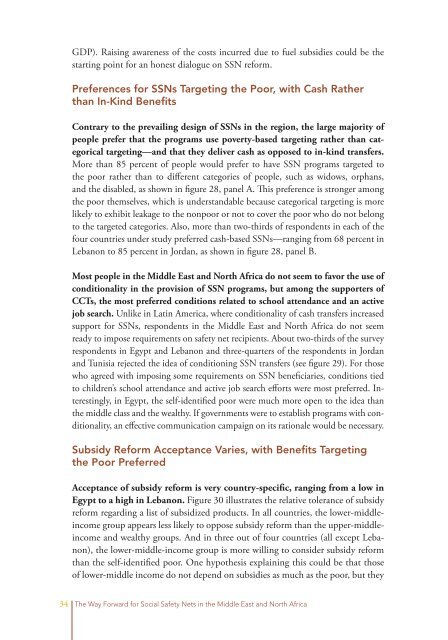Create successful ePaper yourself
Turn your PDF publications into a flip-book with our unique Google optimized e-Paper software.
34<br />
GDP). Raising awareness of the costs incurred due to fuel subsidies could be the<br />
starting point for an honest dialogue on SSN reform.<br />
Preferences for SSNs Targeting the Poor, with Cash Rather<br />
than In-Kind Benefits<br />
Contrary to the prevailing design of SSNs in the region, the large majority of<br />
people prefer that the programs use poverty-based targeting rather than categorical<br />
targeting—<strong>and</strong> that they deliver cash as opposed to in-kind transfers.<br />
More than 85 percent of people would prefer to have SSN programs targeted to<br />
the poor rather than to different categories of people, such as widows, orphans,<br />
<strong>and</strong> the disabled, as shown in figure 28, panel A. This preference is stronger among<br />
the poor themselves, which is underst<strong>and</strong>able because categorical targeting is more<br />
likely to exhibit leakage to the nonpoor or not to cover the poor who do not belong<br />
to the targeted categories. Also, more than two-thirds of respondents in each of the<br />
four countries under study preferred cash-based SSNs—ranging from 68 percent in<br />
Lebanon to 85 percent in Jordan, as shown in figure 28, panel B.<br />
Most people in the Middle East <strong>and</strong> North Africa do not seem to favor the use of<br />
conditionality in the provision of SSN programs, but among the supporters of<br />
CCTs, the most preferred conditions related to school attendance <strong>and</strong> an active<br />
job search. Unlike in Latin America, where conditionality of cash transfers increased<br />
support for SSNs, respondents in the Middle East <strong>and</strong> North Africa do not seem<br />
ready to impose requirements on safety net recipients. About two-thirds of the survey<br />
respondents in Egypt <strong>and</strong> Lebanon <strong>and</strong> three-quarters of the respondents in Jordan<br />
<strong>and</strong> Tunisia rejected the idea of conditioning SSN transfers (see figure 29). For those<br />
who agreed with imposing some requirements on SSN beneficiaries, conditions tied<br />
to children’s school attendance <strong>and</strong> active job search efforts were most preferred. Interestingly,<br />
in Egypt, the self-identified poor were much more open to the idea than<br />
the middle class <strong>and</strong> the wealthy. If governments were to establish programs with conditionality,<br />
an effective communication campaign on its rationale would be necessary.<br />
Subsidy Reform Acceptance Varies, with Benefits Targeting<br />
the Poor Preferred<br />
Acceptance of subsidy reform is very country-specific, ranging from a low in<br />
Egypt to a high in Lebanon. Figure 30 illustrates the relative tolerance of subsidy<br />
reform regarding a list of subsidized products. In all countries, the lower-middleincome<br />
group appears less likely to oppose subsidy reform than the upper-middleincome<br />
<strong>and</strong> wealthy groups. And in three out of four countries (all except Lebanon),<br />
the lower-middle-income group is more willing to consider subsidy reform<br />
than the self-identified poor. One hypothesis explaining this could be that those<br />
of lower-middle income do not depend on subsidies as much as the poor, but they<br />
The Way Forward for Social Safety Nets in the Middle East <strong>and</strong> North Africa



